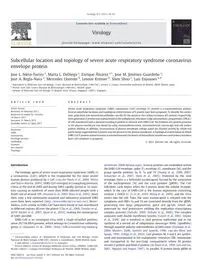
2011 Subcellular location and topology of severe acute respiratory syndrome coronavirus envelope protein PDF
Preview 2011 Subcellular location and topology of severe acute respiratory syndrome coronavirus envelope protein
Subcellular location and topology of severe acute respiratory syndrome coronavirus envelope protein Jose L. Nieto-Torres a, Marta L. DeDiego a, Enrique Álvarez a,1, Jose M. Jiménez-Guardeño a, Jose A. Regla-Nava a, Mercedes Llorente b, Leonor Kremer b, Shen Shuo c, Luis Enjuanes a,⁎ a Department of Molecular and Cell Biology, Centro Nacional de Biotecnología (CNB-CSIC), Darwin 3, Campus Universidad Autónoma de Madrid, 28049 Madrid, Spain b Protein Tools Unit, Centro Nacional de Biotecnología (CNB-CSIC), Madrid, Spain c Institute of Molecular and Cell Biology, 61 Biopolis Drive, Proteos, Singapore 138673, Singapore a b s t r a c t a r t i c l e i n f o Article history: Received 18 February 2011 Returned to author for revision 10 March 2011 Accepted 31 March 2011 Available online 27 April 2011 Keywords: SARS Coronavirus Envelope protein Antibodies Location Ion channel Topology Severe acute respiratory syndrome (SARS) coronavirus (CoV) envelope (E) protein is a transmembrane protein. Several subcellular locations and topological conformations of E protein have been proposed. To identify the correct ones, polyclonal and monoclonal antibodies specific for the amino or the carboxy terminus of E protein, respectively, weregenerated.Eproteinwasmainlyfoundintheendoplasmicreticulum-Golgiintermediate compartment(ERGIC) of cells transfected with a plasmid encoding E protein or infected with SARS-CoV. No evidence of E protein presence in the plasma membrane was found by using immunofluorescence, immunoelectron microscopy and cell surface protein labeling. In addition, measurement of plasma membrane voltage gated ion channel activity by whole-cell patch clamp suggested that E protein was not present in the plasma membrane. A topological conformation in which SARS-CoVEproteinaminoterminusisorientedtowardsthelumenof intracellularmembranesandcarboxyterminus faces cell cytoplasm is proposed. © 2011 Elsevier Inc. All rights reserved. Introduction The etiologic agent of severe acute respiratory syndrome (SARS) is a coronavirus (CoV), which is the responsible for the most severe human disease produced by a CoV (van der Hoek et al., 2004; Weiss and Navas-Martin, 2005). SARS-CoV emerged in Guangdong province, China, at the end of 2002 and during 2003 rapidly spread to 32 coun- tries causing an epidemic of more than 8000 infected people with a death rate of around 10% (Drosten et al., 2003; Rota et al., 2003). Since then, only a few community-acquired and laboratory-acquired SARS cases have been reported (http://www.who.int/csr/sars/en/). Never- theless, CoVs similar to SARS-CoV have been found in bats distributed in different regions all over the planet (Chu et al., 2008; Drexler et al., 2010; Muller et al., 2007; Quan et al., 2010), making the reemergence of SARS possible. SARS-CoV is an enveloped virus with a single-stranded positive- sense 29.7 kb RNA genome, which belongs to Coronavirinae subfamily, genus β (Enjuanes et al., 2008) (http://talk.ictvonline.org/media/g/ vertebrate-2008/default.aspx). Several proteins are embedded within theSARS-CoV envelope: spike(S), envelope(E),membrane (M),and the group specific proteins 3a, 6, 7a and 7b (Huang et al., 2006, 2007; Schaecher et al., 2007; Shen et al., 2005). Protected by the viral envelope, there is a helicoidal nucleocapsid, formed by the association of the nucleoprotein (N) and the viral genome (gRNA). The CoV infectious cycle begins when the S protein binds the cellular receptor, which in the case of SARS-CoV is the human angiotensin converting enzyme 2 (hACE-2) (Li et al., 2003; Wong et al., 2004), and the virus enters into the cell. Then, the virus nucleocapsid is released into the cytoplasm, and ORFs 1a and 1b are translated directly from the gRNA, generating two large polyproteins, pp1a and pp1ab, which are processed by viral proteinases yielding the replication–transcription complex proteins (Ziebuhr, 2005; Ziebuhr et al., 2000). This complex associates with double membrane vesicles (Gosert et al., 2002; Snijder et al., 2006) and is involved in viral genome replication and in the synthesis of a nested set of subgenomic messenger RNAs (sgmRNAs) through negative polarity intermediaries in both cases (Enjuanes et al., 2006; Masters, 2006; Sawicki and Sawicki, 1990; van der Most and Spaan, 1995; Zuñiga et al., 2010). CoV proteins M, S and E are synthe- sized and incorporated in the endoplasmic reticulum (ER) membrane, and transported to the pre-Golgi compartment where M protein recruits S protein and binds E protein (de Haan et al., 1999; Lim and Liu, 2001; Nguyen and Hogue, 1997). In parallel, N protein binds gRNA to Virology 415 (2011) 69–82 ⁎ Corresponding author at: Department of Molecular and Cell Biology, Centro Nacional de Biotecnología (CNB-CSIC), Darwin 3, Cantoblanco, 28049 Madrid, Spain. E-mail address:
